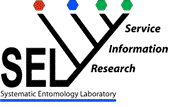Entomology Collections, General

USDA Systematic Entomology Laboratory
Document Type
Article
Date of this Version
2007
Abstract
Morphology-based keys support accurate identification of many taxa. However, identification can be difficult for taxa that are either not well studied, very small, members of cryptic species complexes, or represented by immature stages. For such cases, DNA barcodes may provide diagnostic characters. Ecologists and evolutionary biologists deposit museum vouchers to document the species studied in their research. If DNA barcodes are to be used for identification, then both the DNA and the specimen from which it was extracted should be vouchered. We describe a protocol for the nondestructive extraction of DNA from terrestrial arthropods, using as examples members of the orders Acarina, Araneae, Coleoptera, Diptera, and Hymenoptera chosen to represent the ranges in size, overall sclerotization, and delicacy of key morphological characters in the group. We successfully extracted sequenceable DNA from all species after 1–4 h of immersion in extraction buffer. The extracted carcasses, processed and imaged using protocols standard for the taxon, were distinguishable from closely related species, and adequate as morphological vouchers. We provide links from the carcasses and DNA vouchers to image (MorphBank) and sequence (GenBank) databases.


Comments
Published in Molecular Ecology Notes (2007) 7 , 915–924.